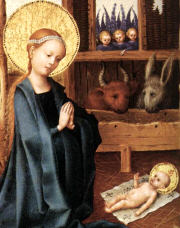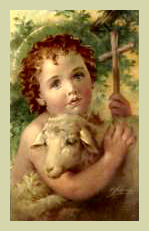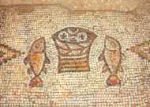January 2025 — Overview for the Month
The Holy Father's Intentions for the Month of January 2025
For the right to an education: Let us pray for migrants, refugees and those affected by war, that their right to an education, which is necessary to build a better world, might always be respected. (See also https://www.popesprayer.net/)
Feasts for January 2025
1. MARY, MOTHER OF GOD, OCTAVE DAY OF CHRISTMAS, Solemnity
2. Basil the Great; Gregory Nazianzen, Memorial
3. Most Holy Name of Jesus , Opt. Mem.
4. Elizabeth Ann Seton (USA and CAN), Memorial
5. EPIPHANY OF THE LORD, Solemnity
6. André Bessette (USA) , Opt. Mem.
7. Raymond of Penyafort, Opt. Mem.
12. Baptism of the Lord, Feast
13. Hilary, Opt. Mem.
17. Anthony, Memorial
19. SECOND SUNDAY IN ORDINARY TIME, Sunday
20. Fabian; Sebastian, Opt. Mem.
21. Agnes, Memorial
22. Day of Prayer for Unborn (USA), Opt. Mem.
23. Vincent of Saragossa (US), Marianne Cope (US), Opt. Mem.
24. Francis de Sales, Memorial
25. Conversion of St. Paul the Apostle, Feast
26. THIRD SUNDAY IN ORDINARY TIME, (Sunday of the Word of God), Sunday
27. Angela Merici, Opt. Mem.
28. Thomas Aquinas, Memorial
31. John Bosco, Memorial
Focus of the Liturgy
The Gospels for the Sundays in January during the Christmas season follow the annual readings from St. Matthew, St. Luke, and St. John. The remaining Sunday Gospels in Ordinary Time are taken from St. Luke following the Lectionary for Year C, and the Weekday readings follow Year I.
January 5 | Matthew 2:1-12: We saw his star at its rising and have come to do him homage. |
January 12 | Luke 3:15-16, 21-22: When Jesus had been baptized and was praying, heaven was opened. |
January 19th | John 2:1-11: Jesus did this as the beginning of his signs at Cana in Galilee. |
January 26th | Luke 1:1-4, 4:14-21: Today this Scripture passage is fulfilled. |
Highlights of the Month  In the first part of January we continue to rejoice and celebrate Christ's coming at Bethlehem and in our hearts. We have the wonderful feasts of Mary, Mother of God, where we honor Mary's highest title, and then we follow the Magi to the crib as they bring their gifts of gold, frankincense and myrrh on Epiphany. Finally we reach the culmination of this season with the Baptism of Our Lord by St. John the Baptist. With a touch of sadness we take down our decorations and enter into the liturgical period known as Ordinary Time where we will devote ourselves to the mystery of Christ in its entirety.
In the first part of January we continue to rejoice and celebrate Christ's coming at Bethlehem and in our hearts. We have the wonderful feasts of Mary, Mother of God, where we honor Mary's highest title, and then we follow the Magi to the crib as they bring their gifts of gold, frankincense and myrrh on Epiphany. Finally we reach the culmination of this season with the Baptism of Our Lord by St. John the Baptist. With a touch of sadness we take down our decorations and enter into the liturgical period known as Ordinary Time where we will devote ourselves to the mystery of Christ in its entirety.
This is a time of growth and an opportunity to allow the dignity of Sunday to shine forth prolonging the joy of Easter and Pentecost. Besides those previously mentioned the month's saint days include:
Mary Mother of God (January 1),
Holy Name of Jesus (January 3),
St. Elizabeth Ann Seton (January 4),
St. Andre Bessette (January 6),
St. Raymond of Penafort (January 7), St. Anthony, Abbot (January 17),
Sts. Fabian and Sebastian (January 20),
St. Agnes (January 21),
St. Francis de Sales (January 24),
Conversion of St. Paul (January 25),
St. Angela Merici (January 27),
St. Thomas Aquinas (January 28)
St. John Bosco (January 31)
The Memorials of St. John Neumann (January 5) and Sts. Timothy and Titus (January 26) are superseded by the Sunday liturgy.
The Winter Seasons  The opening days of January may be cold and nature bleak, but the domestic church still glows warm with the peace and joy of Christmas. We dedicate the New Year to Mary on the January 1st Solemnity honoring her as Mother of God; and on January 8, the Solemnity of Epiphany, we rejoice with her, as her Son is adored by the three Wise Men.
The opening days of January may be cold and nature bleak, but the domestic church still glows warm with the peace and joy of Christmas. We dedicate the New Year to Mary on the January 1st Solemnity honoring her as Mother of God; and on January 8, the Solemnity of Epiphany, we rejoice with her, as her Son is adored by the three Wise Men.
Herald John, who ushered in the Advent season, is present once again to close Christmastide on the feast of the Baptism of Our Lord (The First Luminous Mystery), and to open the Season of Ordinary Time. He points to Jesus, the Lamb of God who unites time and eternity in the Eucharistic Sacrifice, and even January’s diminishing darkness seems to echo St. John’s prayer: “He must increase and I must decrease.”
In this liturgical season the Church eagerly follows Our Lord as he gathers his apostles and announces his mission. At Cana’s wedding feast (The Second Luminous Mystery) he performs his first public miracle at the request of his Mother, and his disciples saw his glory and believed in him.
We, his present-day disciples pray for a like faith as we contemplate the eternal wedding feast of the Lamb and the unique role of the Blessed Mother in the plan of salvation. May we wholeheartedly obey her words of counsel: “Do whatever he tells you.”
This item 12538 digitally provided courtesy of CatholicCulture.org



 January 1
January 1


 A young girl who refused to abandon her practice of the Christian Faith and therefore suffered death at the time of the Diocletian persecution. This symbol expresses her sacrifice for the Faith.
A young girl who refused to abandon her practice of the Christian Faith and therefore suffered death at the time of the Diocletian persecution. This symbol expresses her sacrifice for the Faith.
 One of the Greek Fathers, Bishop of Caeserea, and brother to SS. Gregory of Nyssa and Peter of Sebaste, was a prolific writer and defender of the doctrine of the Incarnation of Jesus Christ. The emblem refers to his building up the Church.
One of the Greek Fathers, Bishop of Caeserea, and brother to SS. Gregory of Nyssa and Peter of Sebaste, was a prolific writer and defender of the doctrine of the Incarnation of Jesus Christ. The emblem refers to his building up the Church.
 The Bishop of Geneva, well loved for his gentleness and moderation, followed the example of Christ by converting through love and patient understanding.
The Bishop of Geneva, well loved for his gentleness and moderation, followed the example of Christ by converting through love and patient understanding.
 A commander of the army in Milan, Sebastian exerted his influence to strengthen and save fellow Christians during the Diocletian persecution. He was denounced and ordered shot to death with arrows, but when it was discovered that he was still alive, he was beaten to death.
A commander of the army in Milan, Sebastian exerted his influence to strengthen and save fellow Christians during the Diocletian persecution. He was denounced and ordered shot to death with arrows, but when it was discovered that he was still alive, he was beaten to death.





